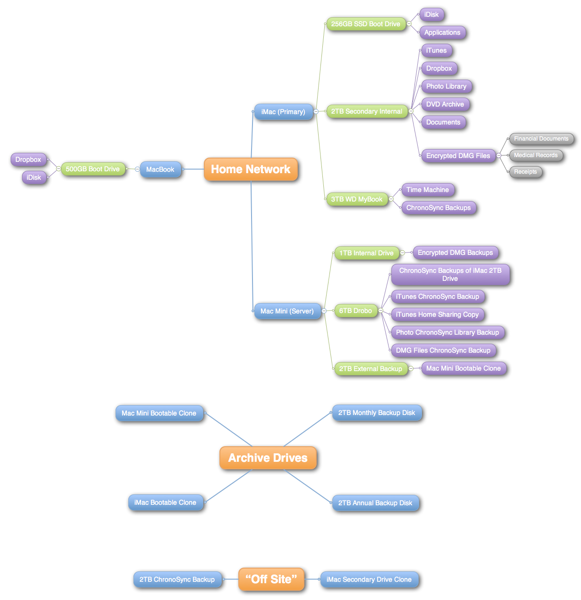A Map of Paranoia
I’m serious about backup.[1] Here’s my current setup:
Primary Machine
I have an iMac (from early 2011) with an internal 256GB SSD boot drive and an internal 2TB spinning platter secondary drive. The secondary drive contains my iTunes, Photo and Documents folders. My Dropbox folder is also on the secondary drive so that the SSD is really just for the OS and Applications.
Secondary Machines
I use a Mac Mini (from early 2010) as a server for FTP, WebDAV and iTunes. It is also setup as a ChronoAgent. That means ChronoSync running on my primary machine can easily backup to a drive on the Mac Mini without the drive directly mounted on the iMac.
I also have a MacBook that is really just used as a mobile machine. I don’t backup the MacBook but I do sync it with Dropbox and iDisk.
We recently donated my wife’s 2008 iMac. She had not used it in almost a year (ever since she got an iPad) so we gave it to her father. He is now a Mac switcher and thrilled to have the iMac. Before that, my wife’s iMac was backed up by ChronoSync through a Mac Mini server.
Backup
Now here’s where the craziness begins. Rather than drone on about the setup, I’ve included a little map that describes the setup.
ChronoSync backups are always performed with “Archive Deletions” on. That means that files that are deleted from the source are moved to an Archive folder on the backup.
System Design
While the system looks complicated, there are only a few principles of the design.
- Files can be restored within 24 hours of any disaster (short of an asteroid impact or solar flare)
- Corruptions in the master data source do not propagate through all of the backups
- Backups are performed automatically
The local backups achieve goal #1. The Off-Site and Annual Archive backups achieve goal #2. The network backups via ChronoSync and TimeMachine achieve the third and final goal of the system. Only the periodic archives require a manual step of retrieving a drive. The ChronoSync scripts for non-clone drives are scheduled to run as soon as the drive is connected. No manual interaction is required to run the backup.
While this may seem like a bit of a headache, it really requires very little work on my part. I have regularly occurring OmniFocus tasks that remind me to bring my off-site disks home and to run the backups. It’s a small price to pay for peace of mind. How would your backup system perform if your house was robbed, burned to the ground or was struck by lightning.
-
3 months after returning from my honeymoon in Tuscany I had a hard drive failure and lost all but a few photos. The only photos that remain of that time were the dozen that I uploaded to MobileMe. That was a huge life lesson: try not to inform your new bride that you lost all of the photos from her honeymoon.
↩

